Development of a Post-Processing Procedure to Characterize Damage in Hybrid Natural Woven Composites Subjected to Low-Velocity Impact by Means of Thermography Techniques †
Abstract
:1. Introduction
2. Pulse Thermography
3. Materials and Set-Up
4. Methods
Data Analysis (Median and 2D fft Filter)
5. Results
6. Conclusions
- The proposed approach increases significantly the signal-to-noise ratio and the capability to detect and characterize the damaged area;
- All the investigated specimens showed both superficial and deeper damage;
- The effect of the momentum is significant in terms of the extension of the damaged area.
Author Contributions
Funding
Institutional Review Board Statement
Informed Consent Statement
Data Availability Statement
Acknowledgments
Conflicts of Interest
References
- Sarasini, F.; Tirillò, J.; Sergi, C.; Seghini, M.C.; Cozzarini, L.; Graupner, N. Effect of Basalt Fibre Hybridisation and Sizing Removal on Mechanical and Thermal Properties of Hemp Fibre Reinforced HDPE Composites. Compos. Struct. 2018, 188, 394–406. [Google Scholar] [CrossRef]
- Fiore, V.; Scalici, T.; Di Bella, G.; Valenza, A. A Review on Basalt Fibre and Its Composites. Compos. B Eng. 2015, 74, 74–94. [Google Scholar] [CrossRef]
- Sarasini, F.; Tirillò, J.; Ferrante, L.; Sergi, C.; Russo, P.; Simeoli, G.; Cimino, F.; Ricciardi, M.R.; Antonucci, V. Quasi-Static and Low-Velocity Impact Behavior of Intraply Hybrid Flax/Basalt Composites. Fibers 2019, 7, 26. [Google Scholar] [CrossRef]
- Saleem, A.; Medina, L.; Skrifvars, M.; Berglin, L. Hybrid Polymer Composites of Bio-Based Bast Fibers with Glass, Carbon and Basalt Fibers for Automotive Applications—A Review. Molecules 2020, 25, 4933. [Google Scholar] [CrossRef] [PubMed]
- Vescovini, A.; Cruz, J.A.; Ma, D.; Colombo, C.; Salerno, A.; Bianchi, O.; Amico, S.C.; Manes, A. Experimental Investigation on Low-Velocity Impact Behavior of Glass, Kevlar, and Hybrid Composites with an Elastomeric Polyurethane Matrix. Compos. Part C Open Access 2024, 13, 100426. [Google Scholar] [CrossRef]
- Sergi, C.; Tirillò, J.; Iacovacci, C.; Sarasini, F. Influence of Reprocessing Cycles on the Morphological, Thermal and Mechanical Properties of Flax/Basalt Hybrid Polypropylene Composites. Sustain. Mater. Technol. 2023, 36, e00648. [Google Scholar] [CrossRef]
- Boccardi, S.; Boffa, N.D.; Carlomagno, G.M.; Del Core, G.; Meola, C.; Monaco, E.; Russo, P.; Simeoli, G. Lock-In Thermography and Ultrasonic Testing of Impacted Basalt Fibers Reinforced Thermoplastic Matrix Composites. Appl. Sci. 2019, 9, 3025. [Google Scholar] [CrossRef]
- Huang, J.; Wei, Q.; Zhuo, L.; Zhu, J.; Li, C.; Wang, Z. Detection and Quantification of Artificial Delaminations in CFRP Composites Using Ultrasonic Thermography. Infrared Phys. Technol. 2023, 130, 104579. [Google Scholar] [CrossRef]
- Maierhofer, C.; Röllig, M.; Krankenhagen, R.; Myrach, P. Comparison of Quantitative Defect Characterization Using Pulse-Phase and Lock-in Thermography. Appl. Opt. 2016, 55, D76. [Google Scholar] [CrossRef]
- Breitenstein, O.; Warta, W.; Langenkamp, M. Lock-in Thermography, 2nd ed.; Springer: Berlin/Heidelberg, Germany, 2010; pp. 7–59. [Google Scholar]
- Delanthabettu, S.; Menaka, M.; Venkatraman, B.; Raj, B. Defect Depth Quantification Using Lock-in Thermography. Quant. Infrared Thermogr. J. 2015, 12, 37–52. [Google Scholar] [CrossRef]
- Salazar, A.; Sagarduy-Marcos, D.; Rodríguez-Aseguinolaza, J.; Mendioroz, A.; Celorrio, R. Characterization of Semi-Infinite Delaminations Using Lock-in Thermography: Theory and Numerical Experiments. NDT E Int. 2023, 138, 102883. [Google Scholar] [CrossRef]
- Maldague, X.P.V. Nondestructive Evaluation of Materials by Infrared Thermography; Springer: London, UK, 1993; pp. 265–450. [Google Scholar]
- He, Y.; Deng, B.; Wang, H.; Cheng, L.; Zhou, K.; Cai, S.; Ciampa, F. Infrared Machine Vision and Infrared Thermography with Deep Learning: A Review. Infrared Phys. Technol. 2021, 116, 103754. [Google Scholar] [CrossRef]
- Mulaveesala, R.; Tuli, S. Theory of Frequency Modulated Thermal Wave Imaging for Nondestructive Subsurface Defect Detection. Appl. Phys. Lett. 2006, 89, 191913. [Google Scholar] [CrossRef]
- Banda, S.S.; Ghali, V.S.; Vesala, G.T.; Mulaveesala, R. Non-Linear Frequency Modulated Thermal Wave Imaging for Subsurface Analysis. Infrared Phys. Technol. 2024, 138, 105248. [Google Scholar] [CrossRef]
- Evans, E.E.; Brooks, R.A.; Liu, J.; Hall, Z.E.C.; Liu, H.; Lowe, T.J.E.; Withers, P.J.; Kinloch, A.J.; Dear, J.P. Comparison of X-Ray Computed Tomography and Ultrasonic C-Scan Techniques and Numerical Modelling of Impact Damage in a CFRP Composite Laminate. Appl. Compos. Mater. 2024, 31, 249–264. [Google Scholar] [CrossRef]
- Almond, D.P.; Pickering, S.G. An Analytical Study of the Pulsed Thermography Defect Detection Limit. J. Appl. Phys. 2012, 111, 093510. [Google Scholar] [CrossRef]
- Chatterjee, K.; Tuli, S.; Pickering, S.G.; Almond, D.P. A Comparison of the Pulsed, Lock-in and Frequency Modulated Thermography Nondestructive Evaluation Techniques. NDT E Int. 2011, 44, 655–667. [Google Scholar] [CrossRef]
- Palumbo, D.; Galietti, U. Damage Investigation in Composite Materials by Means of New Thermal Data Processing Procedures. Strain 2016, 52, 276–285. [Google Scholar] [CrossRef]
- Almond, D.P.; Angioni, S.L.; Pickering, S.G. Long Pulse Excitation Thermographic Non-Destructive Evaluation. NDT E Int. 2017, 87, 7–14. [Google Scholar] [CrossRef]
- Matarrese, T.; Palumbo, D.; Galietti, U. Comparison in the Transient Regime of Four Lock-in Thermography Algorithms by Means of Synthetic and Experimental Data on CFRP. NDT E Int. 2023, 139, 102925. [Google Scholar] [CrossRef]
- Pickering, S.; Almond, D. Matched Excitation Energy Comparison of the Pulse and Lock-in Thermography NDE Techniques. NDT E Int. 2008, 41, 501–509. [Google Scholar] [CrossRef]
- Pitarresi, G. Lock-In Signal Post-Processing Techniques in Infra-Red Thermography for Materials Structural Evaluation. Exp. Mech. 2015, 55, 667–680. [Google Scholar] [CrossRef]
- D’Accardi, E.; Palumbo, D.; Galietti, U. A Comparison among Different Ways to Investigate Composite Materials with Lock-In Thermography: The Multi-Frequency Approach. Materials 2021, 14, 2525. [Google Scholar] [CrossRef] [PubMed]
- Wu, D.; Busse, C. Lock-in Thermography for Nondestructive Evaluation of Materials. Rev. Gév. Therm. 1998, 37, 693–703. [Google Scholar]
- Zhang, H.; Sfarra, S.; Sarasini, F.; Santulli, C.; Fernandes, H.; Avdelidis, N.P.; Ibarra-Castanedo, C.; Maldague, X.P.V. Thermographic Non-Destructive Evaluation for Natural Fiber-Reinforced Composite Laminates. Appl. Sci. 2018, 8, 240. [Google Scholar] [CrossRef]
- Pawar, S.S.; Peters, K. Through-the-Thickness Identification of Impact Damage in Composite Laminates through Pulsed Phase Thermography. Meas. Sci. Technol. 2013, 24, 5601. [Google Scholar] [CrossRef]
- Poelman, G.; Hedayatrasa, S.; Van Paepegem, W.; Kersemans, M. Enhanced Thermographic Inspection of Woven Fabric Composites by k-Space Filtering. Compos. Part B Eng. 2023, 252, 110508. [Google Scholar] [CrossRef]
- Morelli, D.; Marani, R.; D’Accardi, E.; Palumbo, D.; Galietti, U.; D’Orazio, T. A Convolution Residual Network for Heating-Invariant Defect Segmentation in Composite Materials Inspected by Lock-in Thermography. IEEE Trans. Instrum. Meas. 2021, 70, 2515214. [Google Scholar] [CrossRef]
- Matarrese, T.; Marani, R.; Palumbo, D.; D’Orazio, T.; Galietti, U. Influence of Lock-in Thermography Set-up Parameters on the Capability of a Temporal Convolutional Neural Network to Characterize Defects in a CFRP. Opt. Lasers Eng. 2024, 182, 108455. [Google Scholar] [CrossRef]
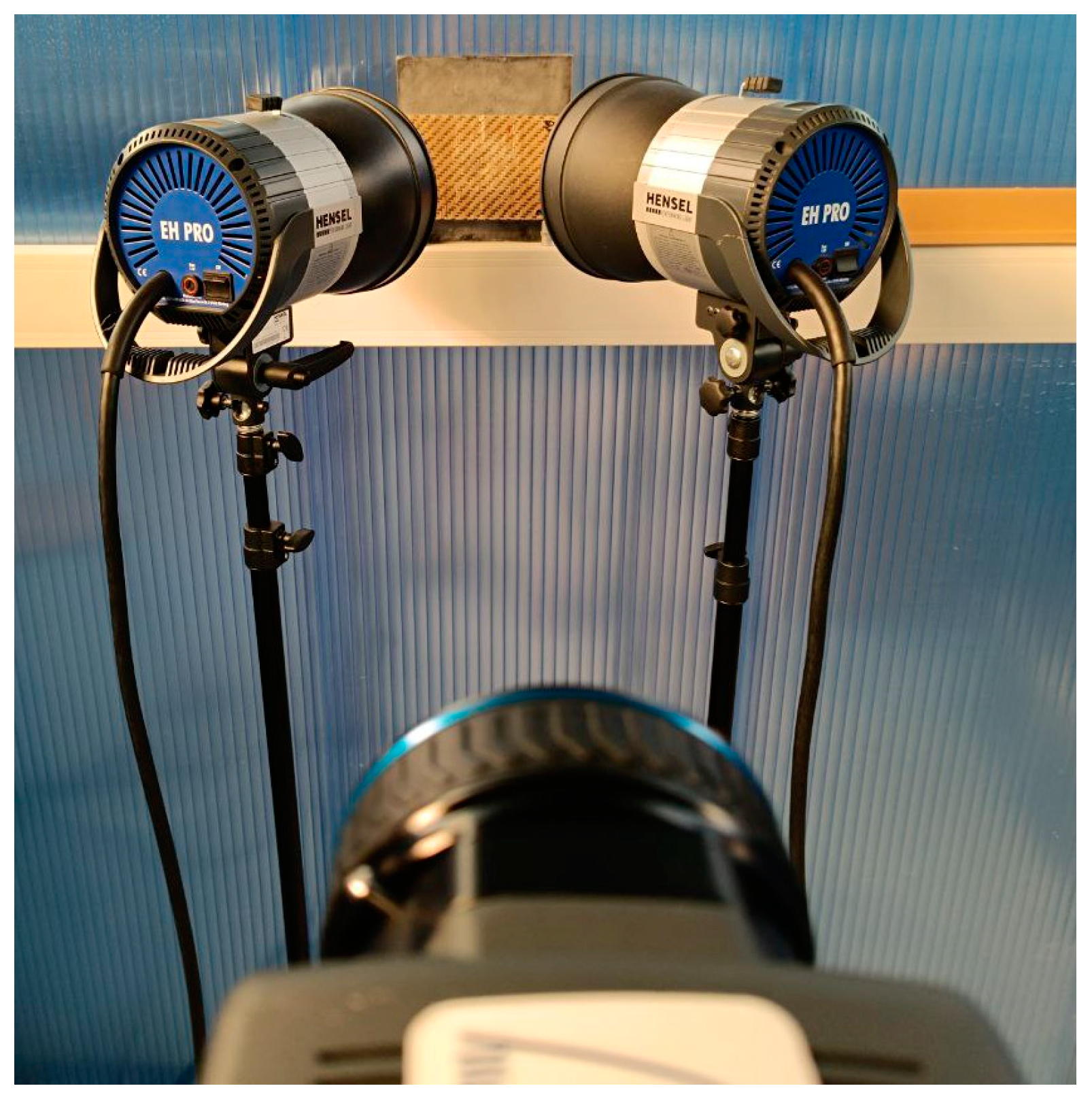
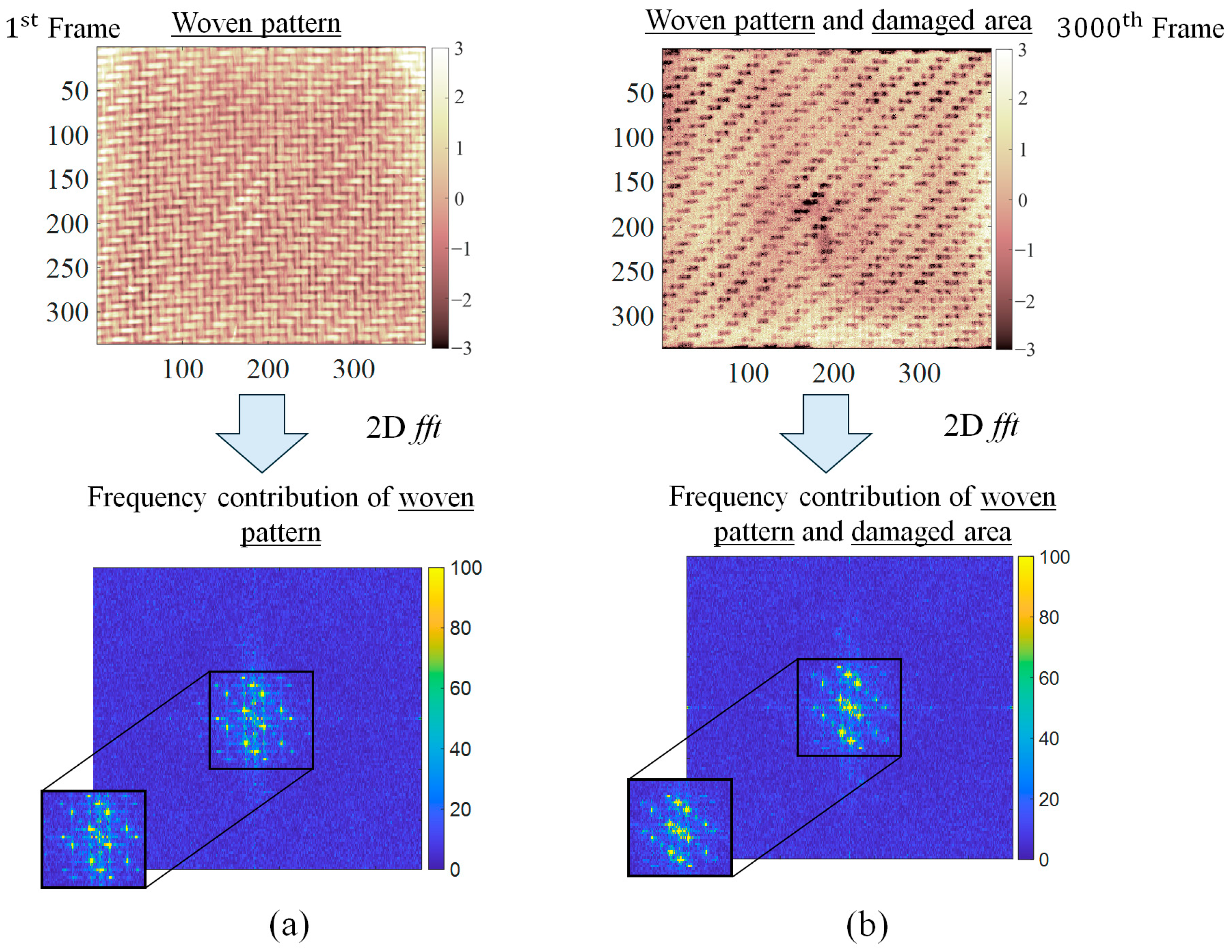
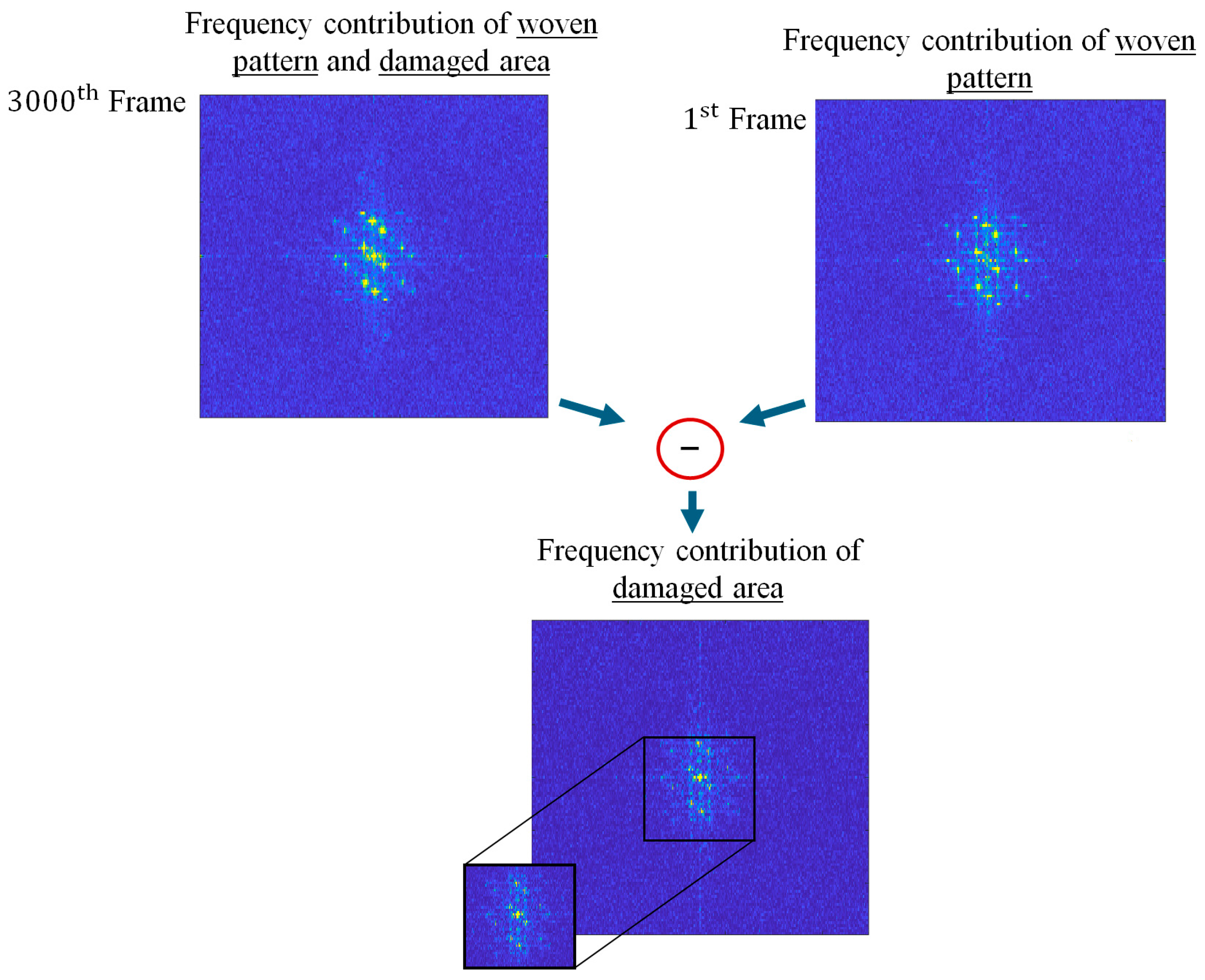

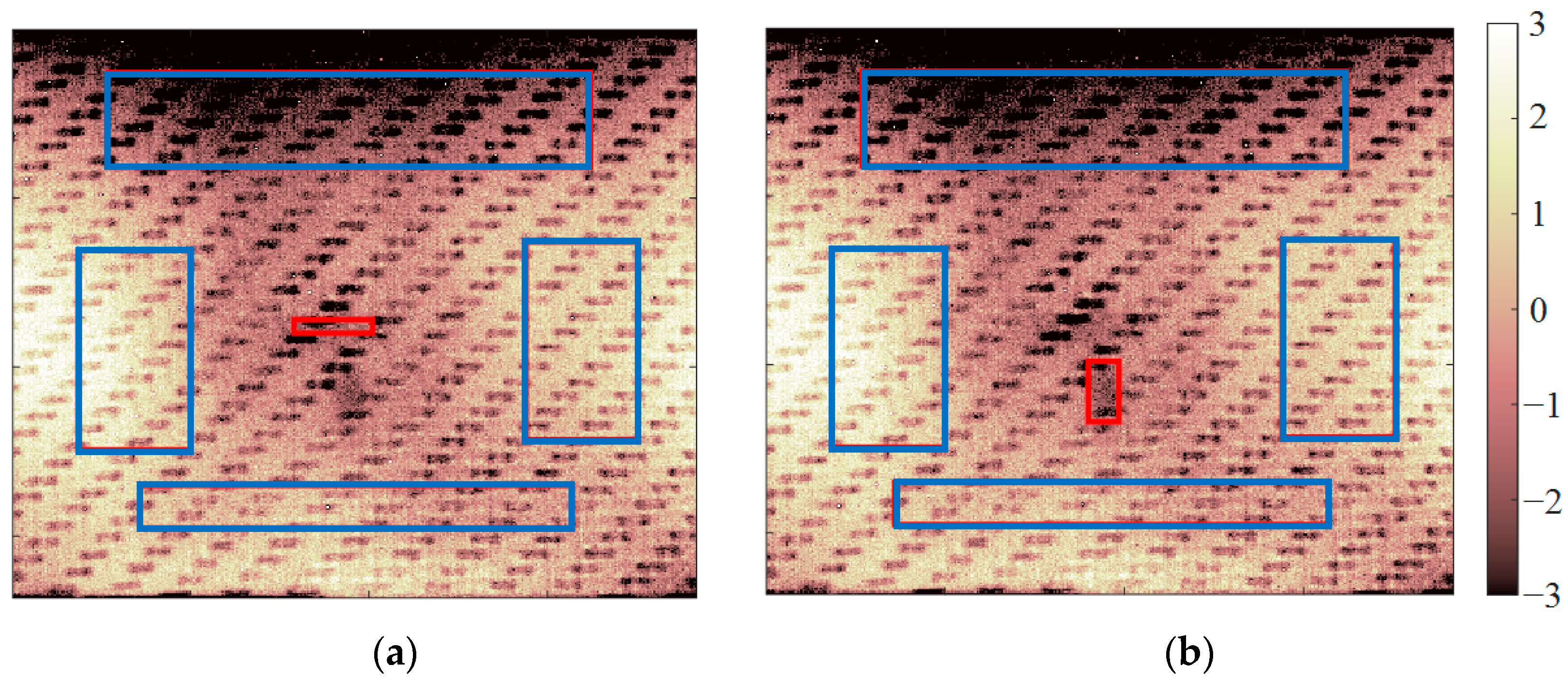
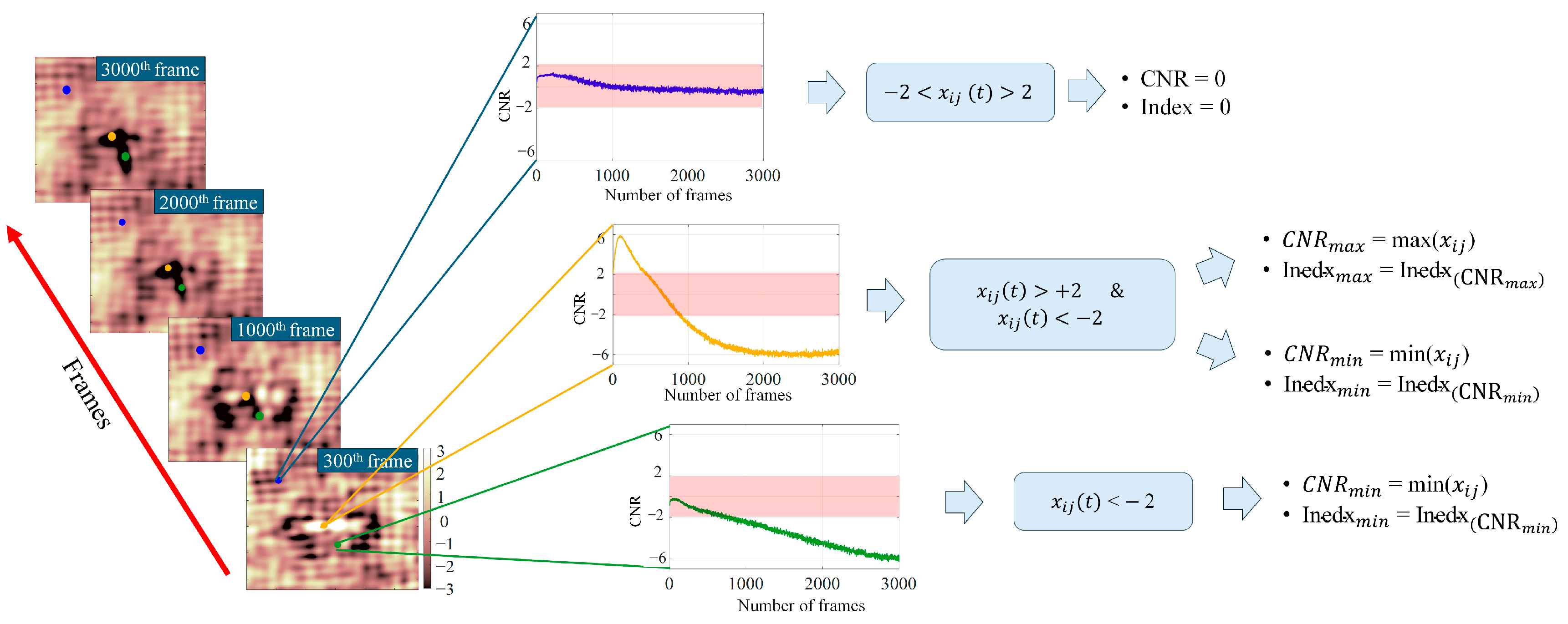
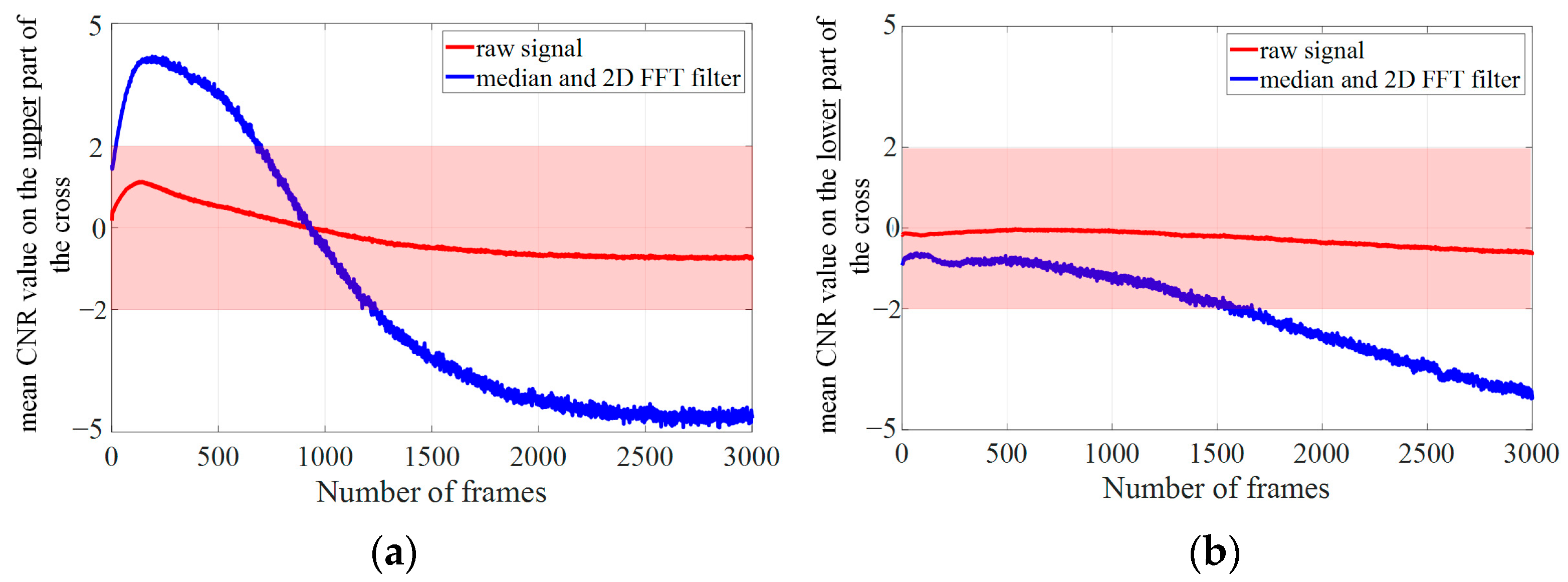



| Specimen N° | Energy (J) | Mass (kg) |
|---|---|---|
| 1 | 3 | 9.055 |
| 2 | 3 | 6.055 |
| 3 | 3 | 3.055 |
| Specimen PPC | Damaged Area (%) | Sound Area (%) |
|---|---|---|
| 3.055 kg | 6.56 | 93.44 |
| 6.055 kg | 28.60 | 71.40 |
| 9.055 kg | 86.80 | 13.20 |
| Specimen PPC | Damaged Area (%) | Sound Area (%) |
|---|---|---|
| 3.055 kg | 11.29 | 88.71 |
| 6.055 kg | 12.55 | 87.45 |
| 9.055 kg | 48.04 | 51.96 |
Disclaimer/Publisher’s Note: The statements, opinions and data contained in all publications are solely those of the individual author(s) and contributor(s) and not of MDPI and/or the editor(s). MDPI and/or the editor(s) disclaim responsibility for any injury to people or property resulting from any ideas, methods, instructions or products referred to in the content. |
© 2025 by the authors. Licensee MDPI, Basel, Switzerland. This article is an open access article distributed under the terms and conditions of the Creative Commons Attribution (CC BY) license (https://creativecommons.org/licenses/by/4.0/).
Share and Cite
Matarrese, T.; Sergi, C.; Palumbo, D.; Sarasini, F.; Galietti, U. Development of a Post-Processing Procedure to Characterize Damage in Hybrid Natural Woven Composites Subjected to Low-Velocity Impact by Means of Thermography Techniques. Eng. Proc. 2025, 85, 51. https://doi.org/10.3390/engproc2025085051
Matarrese T, Sergi C, Palumbo D, Sarasini F, Galietti U. Development of a Post-Processing Procedure to Characterize Damage in Hybrid Natural Woven Composites Subjected to Low-Velocity Impact by Means of Thermography Techniques. Engineering Proceedings. 2025; 85(1):51. https://doi.org/10.3390/engproc2025085051
Chicago/Turabian StyleMatarrese, Tiziana, Claudia Sergi, Davide Palumbo, Fabrizio Sarasini, and Umberto Galietti. 2025. "Development of a Post-Processing Procedure to Characterize Damage in Hybrid Natural Woven Composites Subjected to Low-Velocity Impact by Means of Thermography Techniques" Engineering Proceedings 85, no. 1: 51. https://doi.org/10.3390/engproc2025085051
APA StyleMatarrese, T., Sergi, C., Palumbo, D., Sarasini, F., & Galietti, U. (2025). Development of a Post-Processing Procedure to Characterize Damage in Hybrid Natural Woven Composites Subjected to Low-Velocity Impact by Means of Thermography Techniques. Engineering Proceedings, 85(1), 51. https://doi.org/10.3390/engproc2025085051










